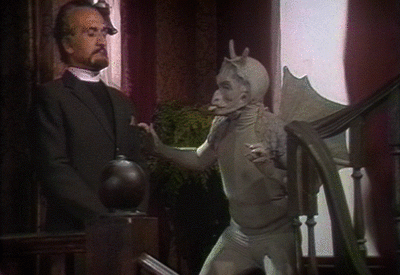The sheer amount of classic Doctor Who now available to stream can leave new viewers unsure where to begin. Here is my personal guide for beginning your journey in the TARDIS with Doctors one through eight.
 With 550 episodes of classic Doctor Who now available on Britbox, new viewers may be confused where to begin (Britbox/ BBC Enterprises)
With 550 episodes of classic Doctor Who now available on Britbox, new viewers may be confused where to begin (Britbox/ BBC Enterprises)
On the 26th of December streaming service, Britbox added every available episode of the classic series of Doctor Who to its platform. The 550 or so episodes had previously been available in other countries such as the US, but this is the first time that millions of viewers have had the opportunity to watch one of the most important and influential series in both science fiction and television history.
There is, however, a downside to this, beneath the surface the 26 seasons of classic Doctor Who form more than one series. Much like its titular character, the key to Doctor Who?s survival and longevity was always its ability to change. And fans of the new iteration of the show may be surprised just how much the show could change in just a short period of time. And these changes were often much deeper than just the face of the lead actor. For example, in a short period in the ?70s, undoubtedly the classic show?s peak period, it went from the military-based action adventures starring Jon Pertwee and helmed by producer Barry Letts, to the ?gothic-horror in space? tales of Phillip Hinchcliffe with the eerie, alien visage of Tom Baker replacing Pertwee?s fatherly and comforting Doctor.
As such, dipping into classic Doctor Who can be, for a new viewer, somewhat daunting. To that end, here is my personal guide of where to begin with classic Who. Make no bones about it though, this is personal. I make no attempt to remove my opinion and love for certain eras of Who and many fans of the classic series will no doubt have their own suggestions, which I welcome in the comments section of this post.
Much like the adventures of the good Doctor, this guide will scoff at the idea of chronology. We will dip in and out of the eras, at will.
The Curse of Fenric
Sylvester McCoy. Season 26. Episodes 8?11
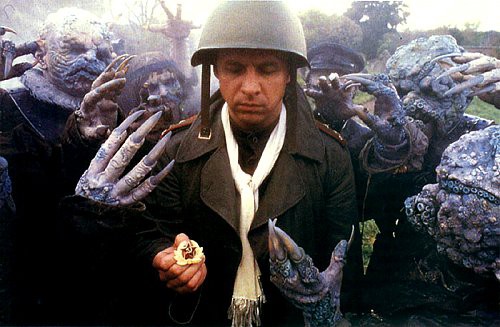 Faith is a useful thing when facing down vampires from the future in The Curse of Fenric (BBC Enterprises 1989)
Faith is a useful thing when facing down vampires from the future in The Curse of Fenric (BBC Enterprises 1989)
This may strike fans as an odd place to start, McCoy?s seventh Doctor is often, not entirely unfairly maligned and this is the second to last serial of the classic series. But, season 26 from which this story is plucked had begun to show that Doctor Who had renewed promise. After the terrible season 24, McCoy?s first and in my opinion the worst single-season of Doctor Who in its history, season 25, the silver anniversary season, had begun to show the green shoots of renewal. In this tale of Norse runes, code-breaking computers, sea-dwelling vampires, cosmic evil and World War II intrigue, those shoots grow into a fully-fledged oak tree.
Much of this is down to then script-editor Andrew Cartmel?s long-term plan for the show. In season 25 he had begun to sow seeds of the idea that the Doctor may be more than just a timelord ? McCoy?s 7th Doctor becomes a Machiavellian schemer and the actor clearly relishes the role. The idea is never clearer than in ?Fenric?. It becomes clear that the Doctor has been manipulating his companion Ace, portrayed by Sophie Aldred, making her a pawn in a deadly game with an ancient enemy.
The story?s strong horror element emerges in the form of Fenric?s pawns, the Ancient Heamavore and his vampiric children, who lurk at the bottom of Maiden’s Point waiting to ensnare Russian infiltrators and rebellious young women alike. The moment that two hapless young victims, now corrupted vampiric slaves lure a Russian soldier to his doom is as chilling and horrific as any in the show?s long history.
The finale of the story takes the form of a battle of wits between Fenric and the Doctor ? who has manipulated his pawns most efficiently and will Ace?s unwavering faith in the Doctor doom them both?
Sadly, the writing was already on the wall for the show at the point that Curse of Fenric aired, but watching the four-parter back, one can?t help but wonder what secrets McCoy?s 7th Doctor was hiding and if his manipulations of Ace were through.
Terror of the Zygons
Tom Baker. Season 13. Episodes 1?4
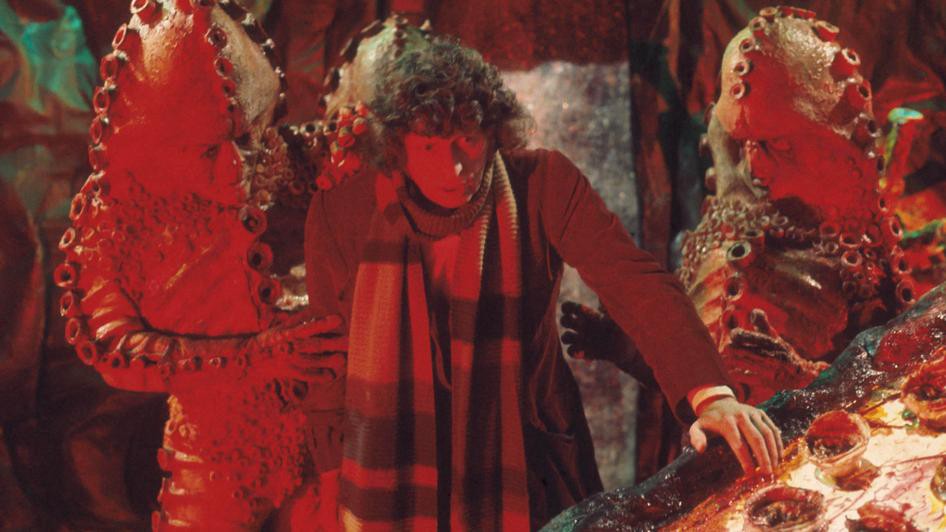 The Zygons and their ship represent some of the most unique design work on the classic show (BBC Enterprises 1975)
The Zygons and their ship represent some of the most unique design work on the classic show (BBC Enterprises 1975)
Originally intended to bring to a close Baker?s first season as the fourth Doctor, Terror of the Zygons, the season 13 opener is notable for several reasons. Firstly, it brings to an end an arc of stories that saw the Doctor, Sarah Jane Smith and Harry Sullivan sent on a mission by the time lords through time and space without the TARDIS ? instead, hanging precariously to a ?time-ring?. This series includes some of the show?s seminal tales ? in particular, Ark in Space and Genesis of the Daleks.
It also marks the dissolution of this tardis team, in my opinion, the finest ensemble cast Who has ever had. Ian Mariner?s bumbling UNIT medic Harry Sullivan played brilliantly off Elisabeth Sladen?s Sarah Jane and the Doctor. It?s a real shame he doesn?t stick around for longer.
The 1975 four-parter also marks the final appearance of Nicholas Courtney as Brigadier Alistair Gordon Lethbridge-Stewart, who won?t appear in the show again until the 20th anniversary season in 1983. With the stalwart Brigadier, UNIT also bid a slight farewell here. Though they?ll appear twice more during Baker?s run, in the excellent Seeds of Doom and the less excellent Andriod Invasion, the removal of the Doctor?s military back-up, a constant in the show since 1970 and all-through Pertwee?s tenure, has the feel of a safety-net being yanked away. It adds an element of danger and really cements the fact viewers can now expect the unexpected from the show.
The story itself is a wonderful mix of the Loch Ness legend, stranded aliens and grim foreboding. Whilst, the Zygons may at first glimpse appear like stereotypical ?bug-eyed monsters? the design is truly unique and despite only appearing once in the classic show, is enough to cement their place amongst its most memorable repeat offenders. Perhaps what is most striking about the shape-shifting enemy is their hissing raspy voice and quiet menace. The design team also create a truly outstanding ship for the creatures, which abandons metal plating, grills, dials and controls for a disgustingly ?organic? feel to the vessel. Their full-reveal at the conclusion of episode 1 looming over Sarah Jane is played to remarkable effect.
What works less well is the oil-rig munching Skarasen, which is mistaken for Nessie in the story. Represented by a glove-puppet it very much exemplifies that idea that with classic-Who sometimes you must take the rough with the smooth. It?s very likely that with all the other positive aspects of Terror of the Zygons, like the carefully built tension and skilful plotting and direction, you won?t care about the janky look of the beast when it finally makes its appearance.
Speaking of janky-looking monsters?
Caves of Androzani
Peter Davison. Season 21. Episodes 17?20.
 First time director Graeme Harper put departing star Peter Davison though the wringer in his final tale, Caves of Androzani (BFI)
First time director Graeme Harper put departing star Peter Davison though the wringer in his final tale, Caves of Androzani (BFI)
Caves of Andozani marks the swansong of Peter Davison?s Doctor and what a send-off it is. Despite being ?my Doctor? it’s understandable why many people feel the boyish fifth Doctor, clad in cricket attire, adorned with a trademark stick of celery ? the use of which is finally explained here in his final tale ? never really hit his stride. Looking back Who during the early ?80s it’s clear that Davison isn?t always comfortable in the role of the Doctor. No doubt due to the fact that his performance is much subtler and natural that Baker?s bombastic fourth Doctor. Anyone, no matter how fine an actor would have struggled to replace Baker, whose seven years in the role meant that many children viewing the show at the time were barely aware that there even were ?other Doctors? by the time old teeth and curls decided to hang-up the scarf for good.
But, any reservations Davison may have had about being a Saturday tea-time hero are firmly cast to the back of his mind by episode four of this gritty tale of arms-dealers, corrupt government officials and scarred maniacs plotting their revenge. In the final episode of the four-part serial, writer Robert Holmes and first-time director Graeme Harper push the fifth Doctor to his limit in a desperate race to rescue Peri ? played by Nicola Bryant ? from the maniacal grasp of Sharaz Jek. Add to this, the fact that both Peri and the Doctor are dying of spectox poisoning and there is only enough to cure one of them.
For me, this final episode represents the finest twenty minutes of Doctor Who in any form. It tells you clearly who the Doctor is, as he willingly lays down his life for a girl he barely knows. Heroism, fierce determination, self-sacrifice and all without hesitation or complaint about his fate.
Oh, and there?s a bloody awful cave-monster that looks terrible and serves no purpose?
The Invasion
Patrick Troughton. Season 6. Episodes 11?18.
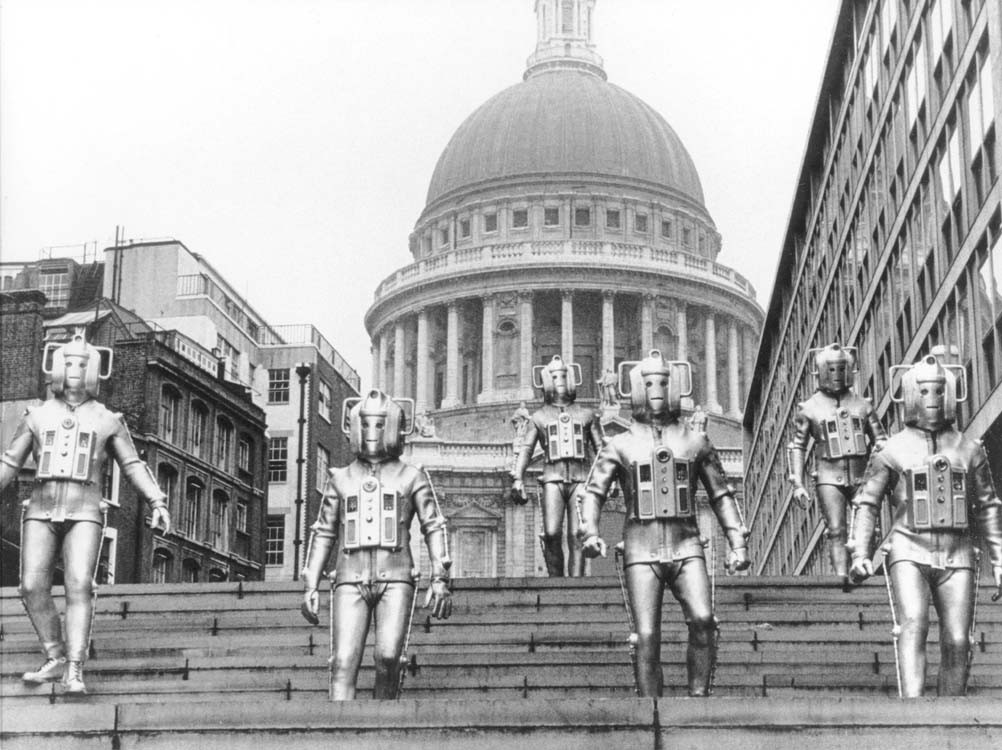 The Cybermen have never looked as good stalking London?s familiar landscape (BBC Enterprises 1968)
The Cybermen have never looked as good stalking London?s familiar landscape (BBC Enterprises 1968)
I love the Cybermen, to me, these relentless, silver, emotionless killers are the epitome of a classic Who monster. And yes, I much prefer them to the Daleks. But, even for a confirmed Cyber-phile it would be difficult to argue that by 1968 some of the shine had come off the part-metal monsters. As the series had found itself in a position where the Daleks could no longer be used, since their first appearance in 1966?s Tenth Planet, the Cybermen had appeared in four serials. Even though this included the bonafide classic Tomb of the Cybermen, it is of little wonder that the audience had grown apathetic to them, especially since all the stories and followed the ?base under siege? template established in that first serial. In fact, most Who fans will tell you, their appearance prior to this, Wheel in Space, was a clear rewrite of Moonbase, their second serail!
To combat this, the producers for this seven-part epic, take the cybermen and place then firmly in contemporary London. They also manage to keep their appearance a secret until half-way into the tale. This means that the story needs a strong-villian to underpin the first four episodes. Which it gets in the form of Tobias Vaughan, a cold-calculating menace who is no mere ally to the Cybermen. In fact, Vaughan?s machinations against the classic-Who foe lead to him using ?weaponised emotions? to drive an unfortunate cyber-soldier mad ? resulting in it embarking on a wailing and murderous rampage through the sewers of London.
The stand-out moment of the seven episodes, however, comes when the Cyber-army emerge from the sewers of London to begin their invasion proper. The sight of the upgraded Cybermen stalking the landmarks of the capital provides one of the shows finest images. The Cybermen had never looked as threatening before, and in my opinion, likely never will again.
Despite renewing the menace of the Cybermen, they would go into hibernation until 1974?s Revenge of the Cybermen after this one, and then until 1982?s Earthshock after that.
Invasion is also well-remembered for acting as the reintroduction of the Brigadier after his introduction in Web of Fear in the previous season. This time, he is more than a standard military man, bringing with him the United Nations Intelligence Task-force or UNIT. As such, Invasion sets the template for the next five years of Who, with a more dynamic, Earth-based action feel.
It?s also worth mentioning, that as a result of the BBC unwisely purging its archives for space in the 1970s, like many episodes of Hartnell and Troughton Who, episodes 1 and 4 are missing. But, fear not, thanks to the efforts of British animation studio Cosgrove Hall, these episodes are beautifully recreated in fantastic detail. This effort to replace these missing episodes is well represented here allowing Who fans to enjoy a classic in its entirety.
Dalek Invasion of Earth
William Hartnell. Season 2. Episodes 4?9.
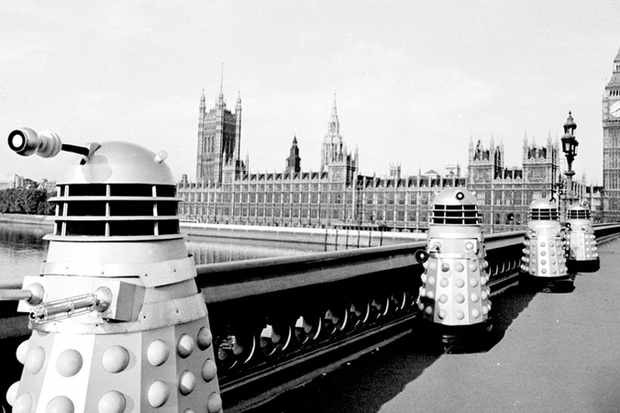 The Daleks rush to remind the Cybermen they did it first. Dalek Invasion of Earth (BBC Enterprises 1964)
The Daleks rush to remind the Cybermen they did it first. Dalek Invasion of Earth (BBC Enterprises 1964)
Even though no Doctor Who list would be complete without a Dalek serial, my choice of Dalek Invasion Earth may surprise some fans. Whilst lists like this normally plump for undeniable classics like Genesis of the Daleks and Remembrance of the Daleks, I feel like there is something truly something special about this six-parter which marks the second appearance of the Doctor?s most famous foes.
This tale feels ?epic? in a way that a lot of classic Who really doesn?t. The Dalek?s conquer of the Earth feels suitably global here and that is quite an achievement given the show?s meagre budget. The limited location shooting around London placing a familiar alien menace alongside a familiar location or landmark is first introduced in Dalek Invasion of Earth and will set up one of the most effective and enduring features of classic Who. Somehow these alien threats are more frightening when seen alongside elements of the audience?s everyday life.
The story is also uncharacteristically gritty for Who at the time. Humans are harvested and processed into the Daleks? zombie-like slaves and characters are dispatched in often harrowing and brutal fashion.
Perhaps the most important element of Dalek Invasion of Earth is that it is the first time the show has to deal with the departure of a series regular and introduce the audience to the idea that the tardis crew will change. In the final episode, the Doctor bids farewell to his beloved Granddaughter Susan. Sensing her desire to stay in 2164 and aware of her blooming romance with a brave resistance fighter, David, and aware that her loyalty to him will never allow her to stay behind, the Doctor locks Susan outside of the TARDIS.
It is at this point Hartnell delivers a heartbreaking speech to Susan, telling her to live her life according to the values he has taught her, and assuring her he will do the same. Bill Hartnell delivers it with conviction and genuine emotion, stemming no doubt in part from the fact he was devastated that Carole-Ann Ford had decided to leave the show. The speech is so ionic that it opens the 1983 Anniversary special The Five Doctors. The crotchety, ill-tempered Doctor softens here, showing his compassion and love for a companion in a way we don?t see much in the classic show. In a way, it?s the moment the Doctor as we know him comes into being. And as the TARDIS fades and Susan leaves her key to the ship she called home behind, for the first time our heart breaks with him.
The Daemons
Jon Pertwee. Season 8. Episodes 21?25
We started with one cosmic horror masquerading as supernatural folklore to and we end with another. The Daemons brings to a close the second season of Jon Pertwee?s third Doctor and all the elements that make this such a fondly remembered era in the show?s history are here. The Master portrayed with glee by Roger Delgado is up to no-good raising ancient evil in the guise of a Reverand in a rural English village. Fortunately, the Doctor and Jo Grant ride into the village in the timelord?s classic yellow roadster Bessie, closely followed by the loyal Mike Yates and the hapless Sargent Benton. And the rest of the UNIT crew aren?t far behind.
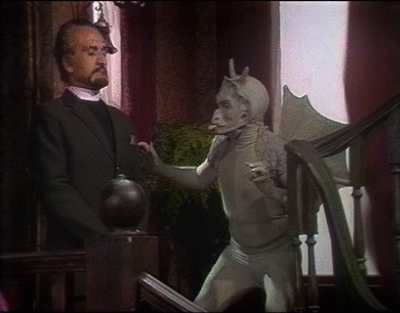 The Master and Bok have fun blowing up villagers in the Daemons. (BBC Enterprises 1971)
The Master and Bok have fun blowing up villagers in the Daemons. (BBC Enterprises 1971)
This one is just good fun ? like classic Who should be. From the Doctor?s frustration trying to teach Osgood (yes they probably are related) another science-bod at UNIT how to ?reverse the polarity of the neutron flow? without things blowing-up in his face, to the gargoyle-like Bok jumping around, zipper clearly showing, happily blowing up villagers. Sure, some parts seem a little silly and the special effects have dated very badly even compared to some of the story?s contemporaries, but for pure entertainment, this mix of the Wicker Man and the Devil Rides Out really shines.
But where was [insert bonafide classic here]?
As mentioned in my introduction, the issue with picking classic Who to recommend is that there is just so much of it that is, well, really good. With the brief list above I?ve tried to maybe highlight a few stories that perhaps don?t get as much attention from other pundits, fans and critics.
Of course, that means I?ve even had to omit some of my favourites along the way. Here neatly categorised are honourable mentions.
Heartwrenching companion farewells
Jo Grant bids farewell to the third Doctor. The Green Death. Season 10
Goodbye Sarah Jane. The fourth doctor drops the inimitable Sarah Jane Smith somewhere that isn?t Croydon. The Hand of Fear. Season 14.
The fifth Doctor is forced to watch as companion Adric kills the dinosaurs (and himself). Earthshock. Season 19.
Gothic Horror/Alien menace
The fourth Doctor faces down the ancient Egyptian god Sutekh ? the finest single appearance villain in the history of Doctor Who. Pyramids of Mars. Season 13.
A monstrous grinning face emerges from a village church wall corrupting the villagers and causing the fifth Doctor a serious psychical infestation problem in his shiny new tardis interior. The Awakening. Season 21.
A future criminal feeds off the lifeforce of Victorian Londoners who are just grateful not to encounter his murderous ventriloquist’s dummy, Mr Sin. This one contains some really dated racial stereotypes, so be warned. The Talons of Weng-Chiang. Season 14.
Dalek and Cybermen classics
The fourth Doctor meets Davros, creator of the Daleks and muses over his ethical right to commit genocide. Rightfully regarded as a classic. The Genesis of the Daleks. Season 12.
The seventh Doctor meets what is left of Davros and has no question about his ethical right to commit genocide. Remembrance of the Daleks. Season 25.
On the frozen planet of Telos, the second Doctor encounters the remains of what an archaeological team believe are the long-dead Cybermen. Tomb of the Cybermen. Season 5.
The Master is up to his old tricks
The Master attempts to team-up with the remnants of an ancient reptilian race. It goes badly wrong. The Sea Devils. Season 10.
The Master ? burnt and deformed beyond recognition ? has used his last regeneration and lurks at the heart of timelord society waiting to snatch the fourth Doctor?s remaining lives. It goes badly wrong. The Deadly Assassin. Season 14.
The Master attempts to harness the second law of thermodynamics to bump off the Doctor. It goes? wait, he actually pulls this-one off. Logopolis. Season 18.
Hey, what about Colin Baker and Paul McGann?
OK, I don?t think that the televised adventures of these two are worth recommending. But, when you have done exploring classic Doctor Who on the small screen, I highly recommend delving into the Big Finish audios. These two Doctors, 6 and 8 respectively, absolutely come into their own in that range, and that is no faint praise. They are most certainly the audios? MVPs.
Published in collaboration with Purple Revolver.
